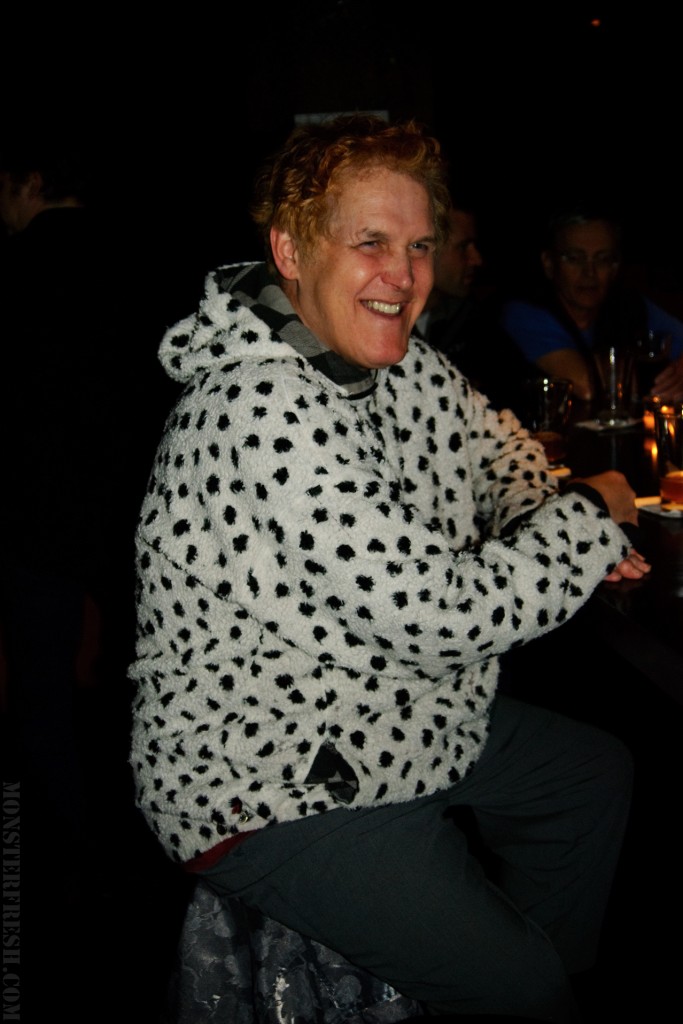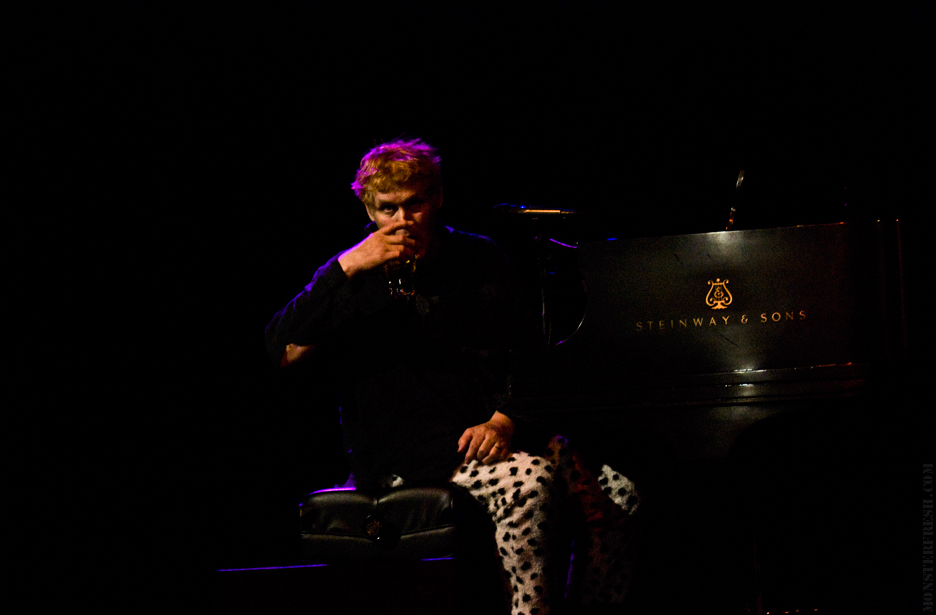Bigger Than the Outside : A Conversation with BABY DEE
 Baby Dee is a fascinating individual. For some, there is a novelty in the fact that she’s transgender, which they’ve allowed to overshadow her work as an artist. For others, her musicianship takes center stage over any personal identity that Baby Dee might have. In reality, the work is far too revealing, honest, and personal to ever be completely separated from the person who created it. In our approach to any interview conversation that we try and conduct on this site, there is a belief that the humanity of the artist and the exploration of them, their history, insights, and experiences as an individual on this planet should always remain a focus, beyond just the art that they create. The “why” is more important for us than the “how”. Even more important is the “who”, because from there the why will expose itself. These concepts became especially relevant in our recent encounter with the Cleveland-born pianist/harpist.
Baby Dee is a fascinating individual. For some, there is a novelty in the fact that she’s transgender, which they’ve allowed to overshadow her work as an artist. For others, her musicianship takes center stage over any personal identity that Baby Dee might have. In reality, the work is far too revealing, honest, and personal to ever be completely separated from the person who created it. In our approach to any interview conversation that we try and conduct on this site, there is a belief that the humanity of the artist and the exploration of them, their history, insights, and experiences as an individual on this planet should always remain a focus, beyond just the art that they create. The “why” is more important for us than the “how”. Even more important is the “who”, because from there the why will expose itself. These concepts became especially relevant in our recent encounter with the Cleveland-born pianist/harpist.
It’s true that Dee continues to build a catalog of deeply engaging and beautiful music, and that is something that we, in no way, wish to discount. We hope to open the door for you to explore her work further, but the sounds and feelings presented in her work are things that you can continue to discover slowly, in your own time. I feel that our job in a piece like this is to attempt to truly help introduce you to the soul of the person behind the work. Baby Dee is a fascinating individual, but I think the point here is that, with or without her affiliations with various other artists, being transgender, or even her abilities as a musician, her unique character and quality as a person would still sustain her as such, regardless. We trust that, after viewing our video interview below, you will see her in the same light as we do. Her talents as an artist are undeniable, but music is little more than a simple medium to manifest and display the immense levels of truth and personal ideals which she holds inside.
Our interview with Dee was conducted by our writer, Sean Prince back on April 28th, 2010. It was filmed prior to her performance at the The Triple Door in Seattle. The show was on a Wednesday. I didn’t find out about it until Sean hit me up with a phone call on that Monday night. I figured that it was probably a shot in the dark, but I contacted Drag City anyway by sending an interview request via email that they wouldn’t receive until Tuesday. Our contact there is really amazing and she was both willing and able to lock down an interview for the next day, by that afternoon. There wasn’t a lot of time to organize, but Sean assured me that he would be prepared. I met with him earlier in the day and we avoided the rain in a coffee shop as he arranged his notes. There is always a bit of anxiety before meeting with a stranger and this is especially true prior to conducting an interview. This time the results would be completely out of my control. I made a few subtle inquiries to Sean, secretly trying to assess his level of preparation. “How did Baby Dee begin playing the harp anyway?” I asked. His response was without hesitation, as he explained the story of how, as a youth, Dee‘s neighbors (“Bobby Slot” and “Freddy Weiss”) smashed the shit out of an upright piano. Their intention was to break it down into small enough pieces to be picked up and disposed of by the garbage man, but the inner harp-like string component of the instrument remained in tact. Dee was drawn to the metallic heart of the splintered wooden beast on the side of the road, plucking at it inquisitively. Sean was clearly prepared and any doubts of that which I may have had quickly dissipated out of my crazy skull. Next, we met with Megan Birdsall, owner of the label Don’t Stop Believin Records, and headed to the venue. Dee met us in the upstairs restaurant/lounge, The Wild Ginger, and I handed Megan a CISCO Flip cam to record the interview. I’ve never been present while another writer conducted an interview and I knew that I could be an anxiety-ridden control freak so, as they headed back into a side room, I opted to wait in the lounge, downing happy hour IPAs and calamari. I am incredibly pleased with the result, as I hope that you will be. We came away with approx. 45 minutes of what I believe may be some of the most thorough and revealing information ever documented about the artist. The footage that we are providing to you now is “unedited” but it has been divided into 5 parts. This way, if you truly want to, you can view one segment and return later to find out more. How Megan held that fucking camera for that long, I don’t know, but it’s appreciated. In my opinion both her and Sean did a remarkable job.

At the risk of dragging this introduction out way too long, there are a few more areas and pieces of information that I feel may be necessary to fill in before viewing the actual interview. Although Dee was touring to promote her latest release, A Book of Songs For Anne Marie, the majority of that album are reworkings of recordings made back in 2002. The original version was accompanied with a book and was was released in a limited run of 150 copies through David Tibet‘s now defunct UK record label, Durtro, back in 2004. Tibet is widely known for his experimental music project, Current 93, which has been his primary creative force since the early 80‘s. Dee herself, also gained a solid amount of notoriety through her performances with Current 93, joining the ranks of other past collaborators, which range from Douglas Pearce (Death in June), Marc Almond (Soft Cell), and Steve Ignorant (Crass) to Tiny Tim, Nick Cave, and Bjork. Dee also owes much of her solo career to David, along with fellow Tibet-credited “discovery” Antony Hegarty of Antony and the Johnsons. Dee has been friends with Antony since the nineties and even provided her harp services on Antony and the Johnsons‘ self-titled debut, also released on Durtro. When Dee started creating her own material, she would record her songs as they were being written. With no real intention of releasing an album of her own, she began sending the recordings to Antony, in hopes that he might be interested in recording one or more of them himself. Antony‘s response was to simply pass them on to Tibet, who then offered Dee the opportunity to release them in the form of an album of her own. Over time, more recordings were released, among them being that original version of Anne Marie. Eventually, Dee was introduced to fellow Drag City musician/Current 93 contributor, Will Oldham (aka: Bonnie Prince Billy, Palace Bros. etc) who, along with Matt Sweeney, later produced the Baby Dee album, Safe Inside the Day [2008 Drag City]. Even back then, Dee‘s intention with the project was to rework A Book of Songs for Anne Marie, until Oldham encouraged her to create new material by venturing into the personal areas that she had been hesitant to explore. The resulting album contains subject matter that references many of the influential characters and situations which surrounded Dee‘s formative years as a youth growing up in Cleveland. One particular standout track, “The Dance of Diminishing Possibilities” addresses the piano smashing incident and features Oldham on backing vocals with Andrew W.K. (yet another Current 93 contributor) manning the drums.
Throughout the interview, you will notice references to everyone from Antony (“Ant”), Andrew, David, Douglas P., old neighborhood residents and more. Hopefully, the previous paragraph will help to fill in most of the gaps. Before Dee took the Triple Door stage to sip scotch and terrorize a Steinway, we were treated to the debut performance of a new duo calling themselves, 200 Years, which is comprised of Ben Chasny (Six Organs of Admittance) and Elisa Ambrogio (Magik Markers). At one point, you’ll see them take the stage in the background for a soundcheck. Alright, I think that’s everything. Hopefully you lazy bastards learn something, but just in case you only come away with one thing from this piece, I hope that it will be the following quote from Dee [taken from the press release form Safe Inside the Day]:
“The inside is bigger than the outside, more
important, and less destructible.“
Thanks, and enjoy
-Dead C